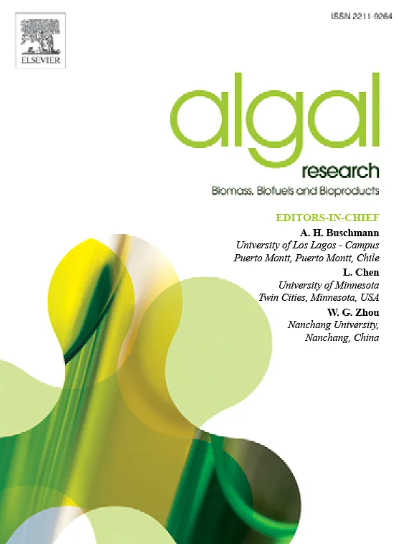Enhancing phycocyanin productivity and thermostability in Synechocystis sp. AUPL1 using Ulva lactuca hydrolysates and ulvan polysaccharides
IF 4.6
2区 生物学
Q1 BIOTECHNOLOGY & APPLIED MICROBIOLOGY
Algal Research-Biomass Biofuels and Bioproducts
Pub Date : 2025-04-19
DOI:10.1016/j.algal.2025.104053
引用次数: 0
Abstract
Increasing the productivity and thermostability of phycocyanin (PC) are key challenges in its industrial production. This study utilized aqueous and acidic hydrolysates derived from the seaweed Ulva lactuca for fed-batch mixotrophic cultivation of Synechocystis sp. AUPL1. The acidic hydrolysate contained higher levels of nutrients and reducing sugars (0.08 mg mL−1) compared to the aqueous hydrolysate (0.03 mg mL−1). Supplementing the cyanobacterial culture with 3 % (v/v) acidic hydrolysate every three days significantly increased biomass productivity, PC content, and PC productivity, achieving approximately 2-, 3-, and 6.5-fold improvements, respectively, compared to the autotrophic control. Additionally, ulvan polysaccharide, extracted from the same seaweed, was tested as a natural preservative to prevent PC degradation at elevated temperatures. Ulvan at 3 % (w/v) significantly extended the PC half-life at 60 °C to 293.21 min, compared to 101.65 min in the control. Thermodynamic analysis confirmed the thermostabilizing effect of the PC-ulvan mixture, revealing that the thermal degradation process was endothermic and non-spontaneous. This study underscores the potential of U. lactuca biomass as a low-cost, sustainable nutrient source for enhancing PC productivity, while also demonstrating that ulvan effectively improves PC thermostability.
利用Ulva lactuca水解物和Ulva多糖提高藻蓝蛋白产率和热稳定性
提高藻蓝蛋白(PC)的生产效率和热稳定性是其工业生产的关键挑战。本研究利用海藻Ulva lactuca的水解液和酸性水解物对聚囊藻(Synechocystis sp. AUPL1)进行分批混合营养培养。与水解解液(0.03 mg mL - 1)相比,酸性水解物含有更高水平的营养物质和还原糖(0.08 mg mL - 1)。每三天在蓝藻培养物中添加3% (v/v)的酸性水解物,显著提高了生物量生产力、PC含量和PC生产率,与自养对照相比,分别提高了约2倍、3倍和6.5倍。此外,从同一种海藻中提取的ulvan多糖作为天然防腐剂进行了测试,以防止PC在高温下降解。3% (w/v)的Ulvan显着延长了PC在60°C下的半衰期至293.21分钟,而对照组为101.65分钟。热力学分析证实了PC-ulvan混合物的热稳定作用,表明热降解过程是吸热的、非自发的。本研究强调了乳酸U. lactuca生物量作为提高PC生产力的低成本、可持续营养来源的潜力,同时也证明了ulvan有效地提高了PC的热稳定性。
本文章由计算机程序翻译,如有差异,请以英文原文为准。
求助全文
约1分钟内获得全文
求助全文
来源期刊

Algal Research-Biomass Biofuels and Bioproducts
BIOTECHNOLOGY & APPLIED MICROBIOLOGY-
CiteScore
9.40
自引率
7.80%
发文量
332
期刊介绍:
Algal Research is an international phycology journal covering all areas of emerging technologies in algae biology, biomass production, cultivation, harvesting, extraction, bioproducts, biorefinery, engineering, and econometrics. Algae is defined to include cyanobacteria, microalgae, and protists and symbionts of interest in biotechnology. The journal publishes original research and reviews for the following scope: algal biology, including but not exclusive to: phylogeny, biodiversity, molecular traits, metabolic regulation, and genetic engineering, algal cultivation, e.g. phototrophic systems, heterotrophic systems, and mixotrophic systems, algal harvesting and extraction systems, biotechnology to convert algal biomass and components into biofuels and bioproducts, e.g., nutraceuticals, pharmaceuticals, animal feed, plastics, etc. algal products and their economic assessment
 求助内容:
求助内容: 应助结果提醒方式:
应助结果提醒方式:


